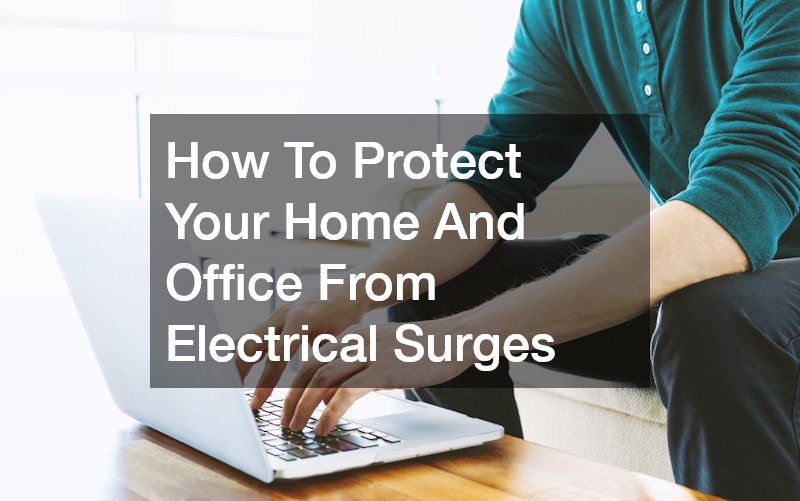

Unfortunately, when looking for power supplies for their home or professional work office, many are more concerned with having enough plugs than finding ways to plug items in while protecting them from a sudden burst of electricty (electricity). So, many will use extension cords and power outlets with multiple plugs to make their office setup work.

However, electronic damage is a very real threat to computers, monitors, and other electronic devices. So, a surge protector is a necessary piece of equipment. When there is a power surge from overloaded circuits, lightning, or tripped circuit breakers, it can cause thousands of dollars in damage to your electronic devices. However, it only costs a small fraction of that to obtain an electrical power surge protector, and it’s as simple as plugging your devices into it to ensure their safety.
Lastly, to be proactive and provide more excellent protection for your office equipment is to hire electricians to install a transient voltage surge protector. It can provide protection from voltage spikes for your entire home or business. Electricians install them at the breaker box, and they send excess electrical currents into a ground wire to keep the extra current of voltage from damaging your equipment. It also gives you peace of mind.
As an important as technology in the average American’s home and to the average American business, the truth is that it is also at risk.
Surveys by ESFI indicate that voltage surges occur monthly and cause significant damage. Sometimes that frequency occurs more often than once a month and healthcare centers (69%), industrial facilities (76%) and IT centers (80%) are among the most affected. In a home or a business, the National Electrical Manufacturers Association estimates that somewhere between 60-80% of surges originate from internal sources.
So what can be done to protect against surges? Electrical design services can help you and there are many things you can do on your own to protect equipment, whether you’re at work or at home:
At work
Surge protectors: One of the best tools a business can have at its disposal is plenty of surge protectors. These must-haves exist to protect computers, chargers and all manner of electrical devices from surges that start at a primary power source.
It’s important to note that the standard voltage in US homes and businesses is 120 volts. Anything that’s well beyond that is considered a surge. When a surge happens, any devices plugged into an unprotected outlet get that surge of power, which can greatly damage equipment. With a surge protector, any excess (or extra) voltage is transferred to the protector’s grounding wire, which stops that extra voltage from reaching any electrical devices.
During electrical storms, you can do yourself a great service by unplugging for electrical office equipment and waiting for the storm to end.
Uninterruptable power supplies: Another thing electrical design services may suggest is uninterruptable power supplies. These machines keep electronic devices going for a set amount of time when power to a building is cut off without warning. Power is essentially stored in a battery and then distributed to keep devices going.
At home
From your laptop or tablet to your TV to all your kitchen appliances, your home has a lot of electronic stuff in it and because it has so many electronics, you need to do all you can to protect them.
So what can you do? You can seek out electrical design services or you can follow these easy DIY steps:
Protect your entire house:
- Protect sensitive areas: A suppressor works great for protecting against surges, but you’re definitely still going to need extra protection for sensitive areas. That means you’ll need to get some power strips or a UPS, which will help give extra protection to areas like your home office or TV area.
- Be smart: When it comes to plugging in electronics at home, you want to make sure you’re extra careful. That means you don’t want to plug an air conditioner into the same power strip as your computer or your printer. Appliances that require large amounts of electricity to run need to be plugged in by themselves and not share outlets with other big-energy items.
- Be mindful of electricity When it comes to your home’s electrical system, you need to be sure the electricity actually has somewhere to go. You need to make sure there’s a pathway that will lead electricity away from your house. Residential electrical services, commercial lighting services, electrical engineering services and companies offering electrical design services can advise you on how best to create an electrical pathway.
There are many things you can do to protect your workplace and your home from surges. By using the methods described above you’ll be able to keep your electronic devices safer and significantly reduce your risk of damage from electrical surges.